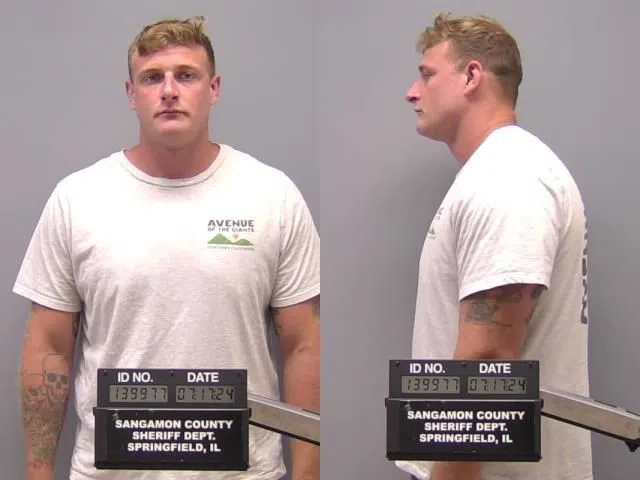PEORIA, Ill. (WMBD) — Sean Grayson’s defense lawyers stressed the importance to the jury that “you don’t owe anyone an explanation of your verdict.”
A Peoria County jury — the case was moved here due to pretrial publicity — will deliberate on whether Sean Grayson should be found guilty or acquitted of first-degree murder charges for the July 6, 2024, shooting death of Sonya Massey.
Jurors will also have the ability to consider a lesser charge of second-degree murder, which carries a possible prison term of four to 20 years behind bars. Probation is also an option.
First-degree murder has a sentencing range of 20 to 60 years behind bars and if jurors find Grayson pulled the trigger — a factor that a 2000 U.S. Supreme Court case requires juries to find — an additional 25 years to life is automatically added onto the range
Updates for other days of the trial can be found below:
- Day 1: Jury Selection
- Day 2: Motions and rulings
- Day 3: Illinois State Police Investigative head takes the stand
- Day 4: Departmental policies
- Day 5: Faculty director of the Excellence in Policing & Public Safety (EPPS) Program takes the stand.
- Day 6: Defense calls expert
This story will be updated below in reverse chronological order
UPDATED (10:16 a.m.) — The defense closing argument went nearly twice as long as the state’s, but that’s common, as after attorney Dan Fultz sits down, State’s Attorney John Milhiser will give a rebuttal to whatever Fultz said.
And the defense attorney packed as much as he could into his nearly 50-minute closing argument. He pointed out that his client didn’t have to testify. It’s his right not to, but he did because he wanted people to hear what he was thinking and what his thought process was that night.
Grayson, the defense attorney, said, gave “clear commands and multiple commands to drop the pot, and it’s true she set the pot down for a minute. But, for reasons that we’ll never know, she reacquired the pot, stood up, and threw it in his direction, and that was when and only when he fired the shots.”
And that was captured on body-worn cameras, the attorney said.
Fultz said jurors can believe what they saw on the video because “that’s what happened.”
“You don’t have to agree with him, but what matters is what Grayson felt in the moment. And at that moment, he felt that using his duty weapon was his only option,” he said.
Like Rodgers before him, Fultz said people need to look at the totality of the situation. And where the prosecutor said that proved Grayson’s guilt, Fultz said it showed the opposite.
Fultz also tried to neutralize prosecutors’ claims that his two experts on use of force were paid to testify in favor of Grayson. Experts, he said, come from all over, and it should be no shock that they differ on how they view things.
And as for being paid?
“I want to tell you something too, this may come as a surprise to you, but every one of the experts is being paid, nobody got paid to come in and lie,”
The defense ended their time by saying the following.
“It remains your choice and your choice alone, you don’t owe anyone an explanation of your verdict, and you certainly don’t owe the state an explanation,” they said.
UPDATED (10 a.m.) — Sean Grayson had other options rather than just shoot Sonya Massey in her house while she was holding a pot of boiling water.
Grayson, 31, could have left through the same unlocked front door that he came into Massey’s Cabbage Patch home, said First Assistant State’s Attorney Mary Beth Rodgers.
“On that day, an annoyed defendant got annoyed and frustrated,” she said. “The defendant started to try and control the situation.
“What he couldn’t control was his anger,” Rodgers said.
Her statements were at the beginning of the state’s closing argument against the former Sangamon County Sheriff’s deputy, who is facing charges of first-degree murder for Massey’s July 6, 2024, death.
The second-floor courtroom in the Peoria County Courthouse was packed with media and family members of the Grayson and the Massey families. Security was high as several guards and officers were inside and outside the room.
Grayson, a Riverton native, sat quietly as Rodgers tore into his testimony from Monday. He wrote occasionally on a notepad, but for the most part, sat and listened.
Rodgers said Grayson set into motion a series of events that led to Massey’s death, and just because he felt threatened at the end doesn’t mean he’s justified in shooting her.
“The defendant knew to slow things down, but he didn’t,” she said. “He knew how to treat her with kindness and respect, but he didn’t.”
“There was no communicating with him, there was no receiving any messages because he snapped,” Rodgers said. “He had achieved his goal. She let go of the pot, but he didn’t care. He wants you to believe he was scared, but you don’t have to believe that because it’s not true.”
She likened it to a person jumping in front of a car and then shooting the driver because they were scared.
As for the statement, “I rebuke you in the name of Jesus,” which Massey said to Grayson seconds before she was shot, that wasn’t a threat, the prosecutor said in open court.
“She made it abundantly clear that she wants nothing to do with him,” Rodgers said.
Jurors will be asked to find him guilty of first-degree murder or if they can find a “mitigating factor,” then to consider second-degree murder, which is a lesser offense.
Such a mitigating factor could be that Grayson was in fear of his life or that he felt he was acting in self-defense.
Jurors will also be asked to find if he was the actual triggerman, a finding that is seemingly obvious, as it’s not in doubt that he shot her. But it’s legally required by a 2000 U.S. Supreme Court case that requires jurors to decide such a factor if it could trigger an enhancement.
Massey, she said, did nothing wrong. She said he was sorry, she put the pot down and she was compiled with the deputy’s orders.
Dan Fultz, Grayson’s attorney, told jurors that Massey’s death, while tragic, was not a crime. And he urged them not to decide their verdict on their emotions but rather on the evidence and the instruction of law.
This case will come down to one very clear point, he said. Was Grayson justified. That’s the only question, he said.
People are eligible to use deadly force if they think they are at risk for serious injury or deadly force. And Grayson, he said, told them he was afraid on the stand.
Grayson isn’t on trial for how he acted as a deputy or if he followed all the generally accepted principles and practices of policing. It’s all about what he felt at the time and whether that was justified or not.
“Did you like his bedside manner, his toxic manner. It doesn’t matter if you like it. It’s not what you are here to decide,” Fultz said.
Rather, people need to look at the incident, less than 30 seconds from things start to go south.
“You can’t go back and look at the outcome and see what should have been done differently,” he said. “That’s the benefit of 20/20 hindsight.
The defense attorney also attacked the testimony of Deputy Dawson Farley, Grayson’s partner that night. Farley was a key witness for the state as he testified that he felt Grayson didn’t act properly and thus, he himself feared what was happening.
But that version didn’t come out until after Grayson was indicted by a grand jury shortly after the shooting, Fultz said. The deputy went back to “clarify” his initial police report with the Illinois State Police, which is mandated by state law to investigate officer-involved shootings.
Fultz also said that Grayson’s statements to Farley after Massey was shot not to get to a medical kit weren’t relevant to the charge of murder. A prosecution witness did testify that if enough pressure was applied, it’s possible Massey would have survived, but Fultz dismissed that.
“The sad truth is miss Massey was never going to survive that incident,” he said, adding that “Nothing that happened after the shooting has any relevance to whether the shooting was justified.”
UPDATE (8:12 a.m.) — Closing arguments will begin shortly, and this is the last time attorneys from each side get to talk to jurors, and it’s where they make their case. They’ll describe what they thought the evidence was and try to sway the jury to their side of the field.
Prosecutors go first, then the defense, and then the prosecution again for what are known as “rebuttal arguments.” The state gets to go twice as they have the burden of proof.
It’s not up for debate who shot Massey — Grayson did. The trial, which began last Monday, is focusing on whether Grayson acted appropriately.
Prosecutors say no, that he violated generally accepted police practices as well as his department’s own policies. But Team Grayson counters that the Riverton native was in fear of an “imminent threat” from Massey, who was holding a pot of boiling water when she was shot by the former Sangamon County Sheriff’s deputy at around 12:49 a.m. inside her home.





